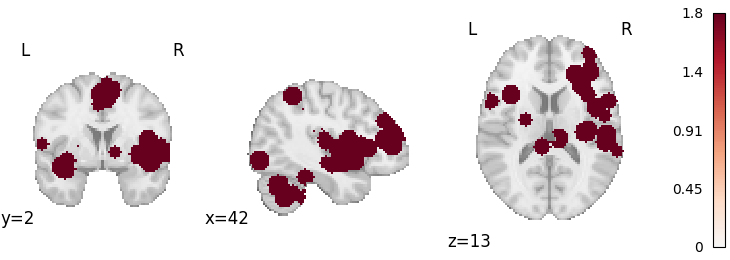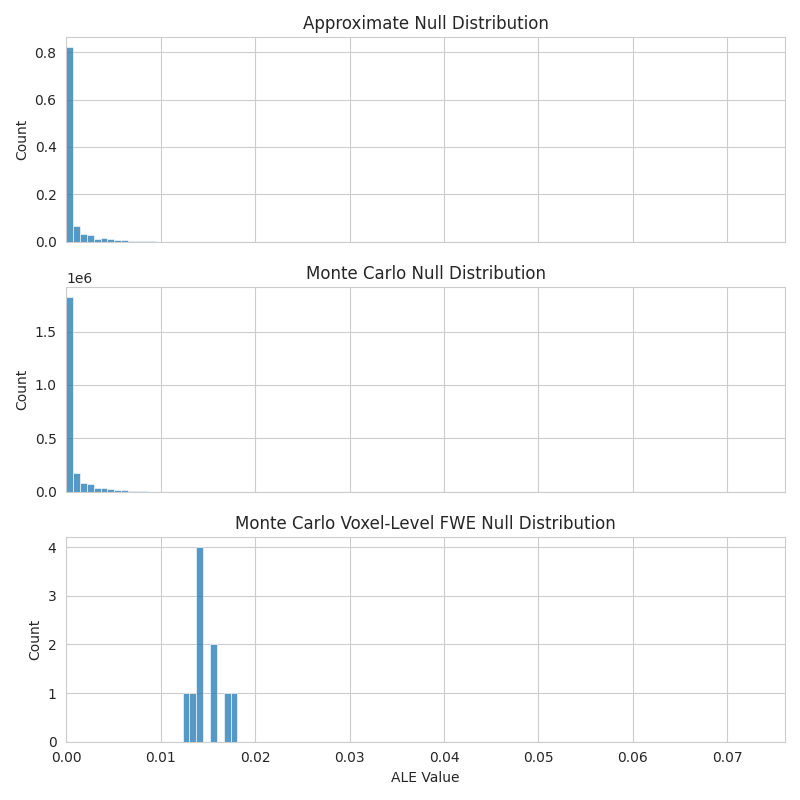Note
Click here to download the full example code
The Estimator class
An introduction to the Estimator class.
The Estimator class is the base for all meta-analyses in NiMARE. A general rule of thumb for Estimators is that they ingest Datasets and output MetaResult objects.
Start with the necessary imports
import os
Load Dataset
from nimare.dataset import Dataset
from nimare.utils import get_resource_path
dset_file = os.path.join(get_resource_path(), "nidm_pain_dset.json")
dset = Dataset(dset_file)
# We will reduce the Dataset to the first 10 studies
dset = dset.slice(dset.ids[:10])
The Estimator
Coordinate-based Estimators allow you to provide a specific KernelTransformer
Each CBMA Estimator’s default KernelTransformer will always be the most appropriate type for that algorithm, but you can swap out the kernel as you wish.
For example, an ALE Estimator could be initialized with an MKDAKernel, though there is no guarantee that the results would make sense.
from nimare.meta.kernel import MKDAKernel
meta = ALE(kernel_transformer=MKDAKernel)
results = meta.fit(dset)
from nilearn.plotting import plot_stat_map
plot_stat_map(results.get_map("z"), draw_cross=False, cmap="RdBu_r")

Out:
<nilearn.plotting.displays._slicers.OrthoSlicer object at 0x7fe0a3ec7bd0>
CBMA Estimators can accept KernelTransformers a few different ways
from nimare.meta.kernel import ALEKernel
Initializing the Estimator with a KernelTransformer class alone will use its default settings.
Out:
ALEKernel()
You can also initialize the Estimator with an initialized KernelTransformer object.
Out:
ALEKernel()
This is especially useful if you want to initialize the KernelTransformer with parameters with non-default values.
Out:
ALEKernel(sample_size=20)
You can also provide specific initialization values to the KernelTransformer
via the Estimator, by including keyword arguments starting with kernel__.
meta = ALE(kernel__sample_size=20)
print(meta.kernel_transformer)
Out:
ALEKernel(sample_size=20)
Most CBMA Estimators have multiple ways to test uncorrected statistical significance
For most Estimators, the two options, defined with the null_method
parameter, are "approximate" and "montecarlo".
For more information about these options, see Null methods.
Note that, to measure significance appropriately with the montecarlo method, you need a lot more than 10 iterations. We recommend 10000 (the default value).
mc_meta = ALE(null_method="montecarlo", n_iters=10, n_cores=1)
mc_results = mc_meta.fit(dset)
Out:
0%| | 0/10 [00:00<?, ?it/s]
10%|# | 1/10 [00:00<00:02, 3.79it/s]
20%|## | 2/10 [00:00<00:02, 3.78it/s]
30%|### | 3/10 [00:00<00:01, 3.82it/s]
40%|#### | 4/10 [00:01<00:01, 3.80it/s]
50%|##### | 5/10 [00:01<00:01, 3.82it/s]
60%|###### | 6/10 [00:01<00:01, 3.83it/s]
70%|####### | 7/10 [00:01<00:00, 3.82it/s]
80%|######## | 8/10 [00:02<00:00, 3.82it/s]
90%|######### | 9/10 [00:02<00:00, 3.82it/s]
100%|##########| 10/10 [00:02<00:00, 3.80it/s]
100%|##########| 10/10 [00:02<00:00, 3.81it/s]
The null distributions are stored within the Estimators
from pprint import pprint
pprint(meta.null_distributions_)
Out:
{'histogram_bins': array([0.000e+00, 1.000e-05, 2.000e-05, ..., 7.247e-02, 7.248e-02,
7.249e-02]),
'histweights_corr-none_method-approximate': array([5.17138782e-01, 1.68074450e-21, 5.51924442e-02, ...,
0.00000000e+00, 0.00000000e+00, 0.00000000e+00])}
As well as the MetaResult, which stores a copy of the Estimator
Out:
{'histogram_bins': array([0.000e+00, 1.000e-05, 2.000e-05, ..., 7.247e-02, 7.248e-02,
7.249e-02]),
'histweights_corr-none_method-approximate': array([5.17138782e-01, 1.68074450e-21, 5.51924442e-02, ...,
0.00000000e+00, 0.00000000e+00, 0.00000000e+00])}
The null distributions also differ based on the null method.
For example, the "montecarlo" option creates a
histweights_corr-none_method-montecarlo distribution, instead of the
histweights_corr-none_method-approximate produced by the
"approximate" method.
Out:
{'histogram_bins': array([0.000e+00, 1.000e-05, 2.000e-05, ..., 7.247e-02, 7.248e-02,
7.249e-02]),
'histweights_corr-none_method-montecarlo': array([873492, 121852, 83620, ..., 0, 0, 0]),
'histweights_level-voxel_corr-fwe_method-montecarlo': array([0, 0, 0, ..., 0, 0, 0])}
import matplotlib.pyplot as plt
import seaborn as sns
with sns.axes_style("whitegrid"):
fig, axes = plt.subplots(figsize=(8, 8), sharex=True, nrows=3)
sns.histplot(
x=meta.null_distributions_["histogram_bins"],
weights=meta.null_distributions_["histweights_corr-none_method-approximate"],
bins=100,
ax=axes[0],
)
axes[0].set_xlim(0, None)
axes[0].set_title("Approximate Null Distribution")
sns.histplot(
x=mc_meta.null_distributions_["histogram_bins"],
weights=mc_meta.null_distributions_["histweights_corr-none_method-montecarlo"],
bins=100,
ax=axes[1],
)
axes[1].set_title("Monte Carlo Null Distribution")
sns.histplot(
x=mc_meta.null_distributions_["histogram_bins"],
weights=mc_meta.null_distributions_["histweights_level-voxel_corr-fwe_method-montecarlo"],
bins=100,
ax=axes[2],
)
axes[2].set_title("Monte Carlo Voxel-Level FWE Null Distribution")
axes[2].set_xlabel("ALE Value")
fig.tight_layout()

Total running time of the script: ( 0 minutes 6.395 seconds)